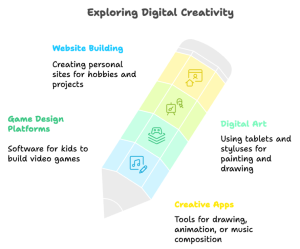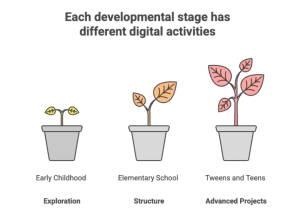Building Imagination, One Pixel at a Time
Discover how digital play, like website building, can boost your child’s creativity. Get tips for safe and imaginative online activities for kids of all ages.
Childhood play is changing, but the goal remains the same: to spark imagination and creativity. While traditional toys and outdoor adventures are timeless, a new world of creative tools is available right at our fingertips. These digital activities open up fresh avenues for kids to dream, build, and express themselves. Far from being a distraction, the right kind of digital play, especially activities like website creation, can expand your child’s creative horizons in incredible ways. You can get started easily with any web builder platform that offers professional, free website templates that give your child a canvas to bring their ideas to life.
This new form of play is not about passively watching videos or tapping through mindless games. It’s about empowering kids to become creators. When children engage with tools that let them design, write, and build, they are actively shaping their own digital worlds. This guide will walk you through how digital activities can boost imaginative skills and how you can support your child on their creative journey.
Understanding Digital Play as Creative Expression
So, what exactly is creative digital play? Think of it as any interactive, creation-focused activity a child does on a screen. This is the difference between consuming content and creating it. Instead of just watching a show, they are writing the script. Instead of just playing a game, they are designing the levels.
Here are a few examples:
- Creative apps: Tools for drawing, animation, or music composition.
- Game design platforms: Software that lets kids build their own video games.
- Digital art: Using a tablet and stylus to paint and draw.
- Website building: Creating a personal site for their hobbies, stories, or projects.
These activities require active participation and critical thinking. They challenge children to solve problems, make decisions, and develop a vision. It’s a hands-on approach to technology that builds skills and confidence, turning screen time into a productive and imaginative outlet.
Benefits for Imaginative Development
Creative digital play offers a unique set of benefits that complement traditional play. It gives children new tools to explore their imagination and share it with others.
Storytelling Through Multiple Media
With digital tools, a story is no longer limited to words on a page. A child can build a website for their fictional universe, complete with character profiles, image galleries, and interactive maps. They can create a blog from the perspective of their favorite book character or produce a short animated film. This multimedia approach helps them think about narrative in a more dynamic and comprehensive way.
Problem-Solving and Logical Thinking
Bringing a digital creation to life is a puzzle. How do I make this button link to the right page? What colours look good together? How should I organise my content so it makes sense to others? Activities like building a website or coding a simple game require children to think logically and systematically. They learn to break down large goals into smaller, manageable steps and troubleshoot when things don’t go as planned.
Self-Expression and Identity Exploration
A personal website or blog is a space for a child to share what matters to them. It can be a portfolio of their artwork, a fan site for their favourite band, or a journal of their thoughts and experiences. This process of curating and presenting content helps them explore their identity and interests. It gives them a voice and a platform to express themselves in a way that feels authentic and meaningful.
Website Creation: A Gateway to Digital Imagination
Of all the digital creative activities, building a website is one of the most powerful. It combines design, writing, and technical skills into one engaging project. It’s a playground where imagination meets structure.
Creating a site sparks creativity on multiple levels. Kids get to be architects, designing layouts and planning how visitors will navigate their pages. They become designers, choosing colour palettes, fonts, and images that reflect their vision. They act as curators, organising content and telling a story through their web pages. A simple drag-and-drop builder allows them to experiment freely, turning what could be a technical task into an artistic one.
From personal portfolios showcasing their drawings to fan sites dedicated to a beloved book series, a website becomes a living project. It can evolve as their interests change, providing a long-term outlet for their creative energy. Best of all, they are learning real-world skills, like project management, user experience design, and content strategy – all while having fun.
Age-Appropriate Digital Creative Activities
Not all digital tools are suitable for all ages. The key is to match the activity to your child’s developmental stage to keep them engaged and challenged, but not frustrated.
- Early Childhood (Ages 3-5): At this age, focus on simple, intuitive apps. Look for digital coloring books, interactive storybooks that let them make choices, and basic music-making apps. The goal is exploration and cause-and-effect learning.
- Elementary School (Ages 6-9): Kids in this group are ready for more structure. Introduce them to drag-and-drop website builders, digital drawing programs with more features, and block-based coding platforms. These tools allow for more complex creations without a steep learning curve.
- Tweens and Teens (Ages 10+): Older kids can handle more advanced projects. They might be interested in designing a website from scratch, starting a blog, or creating multimedia content like videos and podcasts. This is a great time to introduce basic principles of HTML/CSS or more advanced graphic design software.
Balancing Digital Creativity with Other Play
It’s important to find a healthy balance between screen-based activities and other forms of play. One great way to do this is by integrating digital projects with offline interests. If your child loves building with LEGOs, they can create a website to feature photos of their best creations. If they enjoy writing stories, they can publish them on a personal blog. This approach helps connect their digital and physical worlds, showing them that technology can be a tool to enhance their existing hobbies.
It’s also important to establish clear boundaries for screen time. Work with your child to create a schedule that includes time for digital creation, homework, outdoor play, and family activities. This teaches them to manage their time and use technology mindfully.
Practical Tips for Parents
Ready to help your child start their creative digital journey? Here are some tips to guide them effectively and safely.
- Choose Safe Platforms: Look for a website builder and creative apps designed for kids or those with strong privacy controls and content moderation.
- Co-Create and Guide: Sit with your child as they start a new project. Help them brainstorm ideas and navigate the tools, but resist the urge to take over. Let them make their own creative choices.
- Celebrate the Process: Focus on the effort and creativity they put into their work, not just the final product. Praise their clever problem-solving or unique design ideas.
- Discuss Online Safety: Teach your child about privacy from the start. Discuss what information is safe to share online and what should be kept private. Set up parental controls and have open conversations about their online experiences.
Conclusion
Digital play isn’t just a way to keep the kids occupied. It’s quickly becoming a vital part of modern literacy. When children get involved in creative tasks like building their own websites, they’re not only using their imagination but also developing key problem solving skills and finding fresh ways to express themselves.
With the right tools and a bit of guidance, you’re giving your child a cracking opportunity for self expression. By nurturing both their digital know-how and traditional creative flair, you’re setting them up for a future where tech and creativity go hand in hand.




